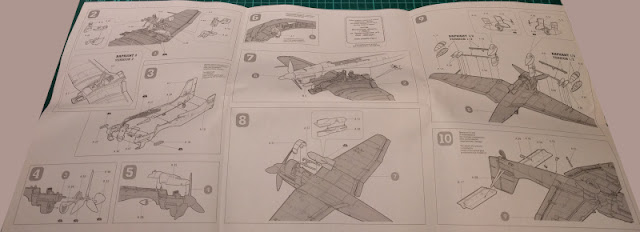Primary
At this point in the project I took the bare minimum surface area to work on, that being the dudes in their seats and the cockpit itself. Then again, as German as a language is full of exceptions and exceptions to those, I also primed the propeller and the spinner already. I just love contradicting myself in one single thought and sentence.The cockpit area
To keep things pretty simple I airbrushed the cockpit floors, walls and the dashboard with dark grey (VMA 71055 (Black Grey RLM 66)) carefully. Had I bothered masking off the wings, I could have saved maybe a few minutes later on. I was somehow expecting to end up filling and sanding the joint of the airframe and wings so I didn't really mind that much. I also painted the cockpit's part on the airframe that is visible outside but under the canopy.Finishing this step I airbrushed the guys yellowish (VMA 71246 Yellow Brown) as that seemed like a pretty decent choice for a desertish DAK coverall and would be distinct from the dark cockpit. Unless I made an utter mess of the canopy in the later stages.
Some manual work
Without any great illusions of anyone ever noticing the dashboard I still dabbed a black (VMA 71057) blobs on just about each of the lumps on the indicator board and then on a bunch of them I added some white (VMA 71001) smudges for better diallikeness. It did look like a dashboard. From a certain point of view. Finally I poked a few bits on the cockpit inner walls with yellow (VMA 71002 Medium Yellow) to mark some random lever ends and whatever they marked that way. Of course I had forgotten to fetch any of my red paints so all those I had to leave this time.While messing around with black I painted the handle of the joystick, the radio devices (2) and the crew's boots (which with these sculpts looked like either walking shoes or that they had their coverall legs over the boots instead of tucked in). Then I prepped their goggles by painting them black as well. Maybe I'd apply something metallic to make them look more like old goggles instead of modern scifi helmet visors. In any case I wouldn't be able to make them look authentic so anything would pretty much be ok for me.
Later I applied some white highlights on the FunkGeräts to make them look a bit more like something else than black cubes in an almost black environment. I didn't go for any special authenticity or anything, just a hightlight for potential visibility.
After I was done with the crew's shoes I painted their bibs (I assume they were lifejackets in real life) with the same yellow I used before. The sculpts were whatever so I just painted instead of worrying too much, as I had made my mind already. You know, being stubborn.
Last but definitely not the least I painted the leathery flying helmets and gloves brown (VMA 71041 Tank Brown). Then I fixed some of their pant legs that hadn't gotten proper airbrush coverage with the yellowish brown.
When I was done with the dudes at this point I painted their seats with the same cockpit colour I used before (RLM 66) and plugged the seats with their owners onto the floor. If I remembered to do the red bits the next time, good, but if I missed the plane wouldn't crash and burn for it. Maybe I could take a look at the seatbelts while I could. Otherwise the next round would (hopefully) be just pure building again.





























































